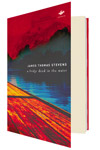It’s more than a coincidence that the word uncultivated commonly refers both to someone lacking sophistication and to land considered wild. In response, James Thomas Stevens’s A Bridge Dead in the Water turns the notion of cultivated upside down, in the process exposing the barbarism it conceals. Ideas and directives concerning proper care of the self and the environment don’t arise in a vacuum, and one of the most striking aspects of Stevens’s poetry is its complex layering of the personal and the historical. A writer of Native American descent, his vision extends geographically from the United States to Asia to the Middle East and chronologically from the present back five hundred years to what some deem the age of discovery and others call an invasion.
In articulating this vision, Stevens probes the borders of language and memory—as what’s shared not only between individuals but also between cultures. As a result, much of his poetry consists of fragmented narratives in which contact is a form of disruption—the intrusion of an outside as history and as other. Stevens’s work depicts borders as shifting yet very much real; beginning with his first book, Tokinish, he’s compared bodies to islands. This becomes clear in recent poems occasioned by a trip to China: “No making opposite shores connect, / the landbridge dead in the water. // If I name the rapid—La Chine / it does not bring China closer.” It may be the case that the more serious and attentive the attempt at encounter, the deeper the awareness of differences.
For Stevens, contact is most intimately experienced in “the text of touch.” A lyric poet of love and its accompanying damage—personal and collective—Stevens’s work is erotic, and homoerotic, while almost always allegorical in depicting this love. In the first poem in a short set dedicated to seventeenth-century missionaries martyred in and around upstate New York, he writes: “To kiss the stake / one’s bound to // fall to erotic postures.” Despite his obvious disapproval of the priests’ efforts to convert the local inhabitants to Christianity, Stevens—like the Christian saints themselves—revels in the ecstasies of their suffering, itself the product of religion, violence, and ritual’s reciprocating mix.
Nevertheless, A Bridge Dead in the Water offers the possibility for healing and reconciliation. Among the strongest sections of the book is “The Mutual Life,” a series of poems describing injuries and cures drawn from an old insurance company text. True healing, like love, is what undoes you, and the poems of “The Mutual Life” are broken in their telling, with “remedies” occupying only a single page at the end haunted by the image of “Our portrait, a thin red line in a field of white.” Here, disease is integral to healing—a homeopathic approach, in contrast to a more conventional use of medicine to disguise symptoms. Similarly, meaningful reconciliation never forgets the conflict preceding it.
In the final long poem, Stevens puts the “alphabet out of order” at the same time that his poetry becomes more direct in condemning the destruction of indigenous cultures and the current war in Iraq: “Alaska. Iraq. You will be removed.” An imaginary primer for “Native or Confused Americans,” the poem investigates the ways in which imposed languages and cultures are equivalent in destructive power to military weapons. In doing so, Stevens’s poetry presses its hand to a wound with language leaking through the fingers.





